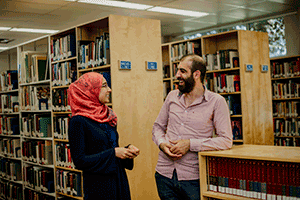Ready to learn more?
Get all the details straight to your inbox!

Luther College students are eligible for nearly $100,000 in academic awards – in addition to scholarships and bursaries awarded by the U of R.

The Luther Library has over 24,000 items in its collection, 5,000 books checked out per year, and 7,000 students who come through its door per month.

Free enrolment counselling support and invaluable one-on-one academic advising are available for all programs at Luther College.

Living in The Student Village at Luther College, our student residence, comes with a choice of healthy, nutritious meal plans. That means no grocery shopping, no meals to cook, and no dirty dishes to worry about. You can focus on your studies and wellness!

Smaller class sizes at Luther College means more individualized attention and better connections with your professors, classmates, and academic advisors.

Luther College offers Bundles programs that group together first-year students and classes to give you a great start and help ease the transition from high school to university.

Every degree program at Luther College offers a study abroad option and an optional experiential learning component where you gain real world experience and get paid while going to school!

To enrol as a Luther College student, simply fill out the University of Regina application form and select Luther as your campus of choice.
Get all the details straight to your inbox!
Although witchcraft persecutions occurred throughout all of early modern Europe, the concept of the witch and the magnitude of the trials differed significantly between England and continental Europe. On the continent, where the witch trials first originated, an association with the Devil was one of the main indications that someone was a witch. In England, however, inflicting harm upon others, or causing maleficium, usually led to accusations of witchcraft. Compared to the witch trials on the continent, there were fewer witch trials in England, and the conviction rates were much lower. English demonologists attempted to define what evidence was sufficient to convict a witch, which may have led to the lower conviction rate. The common law court systems in England, which used a combination of juries and experienced judges, and forbade the use of torture in the trials, also influenced the lower conviction rate.
The witch trials of 1645, which were led by Matthew Hopkins during the English Civil War, had a far higher conviction rate compared to other English witch trials. By contrasting the typical English witch trials with the trials of 1645, we can reveal the elements that were necessary for large-scale witch hunting throughout Early Modern Europe. These elements included political instability, the use of torture within the trials, the presence of a professional witch hunter and an increase in the belief that witches associated with the Devil. The trials of 1645 exposed the unreliable evidence and inhumane methods involved in witch trials, which eventually led to the end of the English witch trials.
Many of the witchcraft accusations in England were based on the belief that someone had inflicted harm upon others, otherwise known as causing maleficium. According to the court accounts from the Home Circuit Assize Courts, where many cases of witchcraft were tried, 94% of all accusations of witchcraft were based on charges of maleficium.[1] In England, when a richer family suffered a misfortune, they would often accuse someone who was a nuisance in society of witchcraft. One scenario that occurred often was if someone refused a beggar money or food, and then later fell ill, that person would accuse the beggar of witchcraft. In Macfarlane’s examination of the witch trials in the English county of Essex, the author suggests that this common scenario was due to the widening gap between the rich and the poor.[2] The population increase in the mid-sixteenth century caused this gap, and richer villagers may have become uncertain with how to deal with the increasing number of poor people.[3]
Central to the continental concept of the witch was the belief that witches formed a pact with the Devil and attended his Sabbath. However, this was not a common belief in England. Although some English court accounts depicted witches gathering to plot maleficium or dine with the devil, they were not thought to engage in sex with the Devil.[4] In the continental trials, many of these beliefs became popular because witches confessed under torture that they had made a pact with the Devil or attended his Sabbath. However, the English courts did not allow torture, so the accused witches did not usually confess to associating with the Devil. Although confessions were considered the best form of evidence, they do not appear to have been solicited during the majority of the Essex trials.[5] Therefore, the witches’ association with the Devil did not become prominent in England.
The Act against Conjurations, Enchantments and Witchcrafts, which was passed in 1563 during the reign of Queen Elizabeth I, demonstrates how the continental witch trials influenced the beginning of England’s witch trials. This Act was passed at a time when Protestant English churchmen were returning to England from Europe after escaping persecution during Queen Mary’s reign. Some of them may have convinced Elizabeth that witchcraft should be punishable as a crime, as evidenced by the sermon John Jewel preached to Queen Elizabeth where he encouraged her to prosecute witches.[6] However, the Act emphasized the English concept of the witch as someone who causes maleficium. According to this Act, killing someone through witchcraft was the only offence that was punishable by death for the first offense. Lesser forms of witchcraft, such as causing injury through witchcraft, were punishable by a year in prison and four appearances in the public pillory.[7]
When James I became King of England in 1604, he passed a new Act that made almost all forms of witchcraft punishable by death.James came from Scotland, where the witch trials were more common and followed a continental pattern. He also believed that witches had caused a storm to occur once when he was sailing from Denmark to England with his bride.[8] In response to this experience, he wrote his Daemonologie in 1597, where he emphasized that anyone who practised witchcraft should receive the death penalty.[9] Once he became King of England, he passed the Act of 1604, which made it a capital offense to kill or harm others through witchcraft, consult with evil spirits “for any intent or purpose” or dig up graves to use the dead bodies in witchcraft.[10] This change in the concept of the witch emphasized the association of witches with the Devil, which was more in line with continental theory.
Surprisingly, the Act of 1604 led to a decrease in witchcraft convictions in England because a witch’s association with evil spirits was more difficult to prove in courts without the use of torture.The conviction rate for witches from 1598-1608 was at 41 per cent, but it fell to 17 per cent from 1608 to 1617, which was during King James I’s reign.[11] Under the Act of 1563, most witchcraft trials were based on charges of maleficium. It was relatively easy to provide evidence for these trials because the courts only had to prove a connection between the suspected witch and her victim. However, it was harder to provide evidence for the trials after 1604 that were based solely on a witch’s association with evil spirits.[12] On the continent, confessions obtained under torture were often used as evidence that a witch had associated with evil spirits. However, since England did not allow torture, few witches confessed to associating with evil spirits, as evidenced by the records from the Essex trials.[13] This may have led to the gradual decrease in witchcraft convictions after the Act of 1604.
Overall, the witch trials in England had a lower execution rate than the trials in Europe.In the Home Circuit Assizes, 22 per cent of the witches accused were executed through hanging from 1560-1709.[14] In comparison, 90 per cent of the witches were executed in the Pays de Vaud region in France between 1537 and 1630.[15] Unlike the continental demonologists, English demonologists attempted to define the type of evidence that was sufficient to convict witches, which may have influenced the lower execution rates. The English sceptic Reginald Scot first noted the lack of reliable evidence used to accuse vulnerable old women of witchcraft.[16] William Perkins later suggested that convictions of witches “must proceed from just and sufficient proofes, and not from bare presumptions.”[17] Even King James I, who fully supported the execution of witches, thought evidence should be carefully considered in a witchcraft case. One example occurred in Leicester in 1616, where James found a 12-year-old boy’s testimony to be unreliable and ordered the release of the remaining accused witches.[18] In 1618, Michael Dalton wrote The Countrey Justice to advise the courts on what evidence they could use to convict witches.[19] Overall, the English courts were more reluctant to execute witches based on questionable evidence.
The low execution rate of witches in England was also largely due to the relatively lenient English court system.The conviction rate of witches in the English courts was comparable to other crimes tried in England. For example, while 32 per cent of those accused of witchcraft were punished in the Home Circuit Assizes, 29 per cent of those accused of homicide were punished in the Essex Assizes and quarter sessions.[20] Although various levels of courts were authorized to try witchcraft in England, the assize courts tried most witchcraft cases.[21] Twice a year, two assize judges travelled along the English circuits to try major crimes such as witchcraft. These experienced judges were removed from the local tensions that often surrounded the witchcraft cases, which resulted in lower conviction rates.[22] In towns with local municipal courts, the conviction rates were often higher because the judges had less experience and were more involved in local conflicts. For example, in Faversham the local municipal court executed a woman suspected of witchcraft, although she probably would have received a lesser punishment in the assize courts.[23]
The English courts used a common law system instead of the Roman law system used on the continent, which contributed to the lower conviction rates in England. Torture was not officially allowed under the common law system unless treason was involved, so the conviction rate decreased due to the decrease in confessions.[24] The common law system also used a combination of different judges or juries instead of having one person in charge.[25] In contrast, many professional witch hunters on the continent caused witch crazes because they benefited from convicting witches. In England, the only professional witch hunter who caused a major witch craze was Matthew Hopkins in 1645.
The trials of 1645 led by Matthew Hopkins in East Anglia had a much higher conviction rate than other English witch trials. During the summer of 1645, Hopkins tried approximately 200 witches.[26] The number of executions during these trials accounted for one-quarter of the entire English total of executions.[27] These trials resembled continental witch trials rather than English witch trials, since they occurred during a time of political instability and were led by a professional witch hunter who used torture within the trials to increase the belief that witches associated with the Devil. England was going through a Civil War at the time, so the normal assize courts were suspended. The resulting political tension led to an increase in belief that the Devil was at work, which led to an increase in witchcraft accusations.[28] The borough courts also hired Matthew Hopkins to try witches instead of relying on the assize courts. Since Hopkins was expensive to hire, it was difficult to dismiss his conclusions.[29] Hopkins used sleep deprivation as a form of torture to gain confessions about associations with the Devil.[30] As a result, more than half of the witches confessed to having met the Devil and many confessed to having sexual intercourse with him.[31] Hopkins’ methods, which worked especially well during a time of political conflict, led to an increase in witch convictions.
Ironically, the Matthew Hopkins trials may have helped to bring an end to the English witch trials because they brought to the attention of the English elite the flawed evidence and inhumane methods used in witch trials. John Gaule criticized Hopkins for using inhumane methods such as sleep deprivation to try witches, which often led to delusions.[32] For example, one witch who was sleep-deprived confessed to owning two devilish creatures known as familiars, but she had no memory of them after she had rested. The trials also used the presence of a witch’s mark on the skin to prove that someone was a witch. Others began to question the evidence of the witches’ mark, which was difficult to distinguish from natural marks on the skin.[33] Hopkins’ peers determined that laymen like Hopkins were not authorized to conduct witch trials.
The practice of maleficium defined the concept of the witch in England. Although King James I tried to emphasize the association of witches with the Devil through his Act of 1604, the conviction rate actually decreased during his reign because of the lack of reliable evidence that could convict witches without using torture. The emphasis on reliable evidence in witch trials and the relatively lenient common law court system in England influenced the low conviction rate of witches in England. The Hopkins trials of 1645 contained many factors typical of continental trials including political instability, the presence of a witch hunter who used torture and an increase in the belief that witches associated with the Devil. Overall, contrasting the Matthew Hopkins trials with the typical English trials reveals how a country’s political climate, court systems, and beliefs about witches influenced the outcome of their witch trials.
[1]J.A. Sharpe, Instruments of Darkness: Witchcraft in England, 1550-1750 (London: Penguin, 1996), 113.
[5]Alan Macfarlane. Witchcraft in Tudor and Stuart England: A Regional and Comparative Study, 2nd ed, (London: Routledge, 1999), 19.
[6]Wallace Notestein, A History of Witchcraft in England from 1558-1718 (New York: Russell and Russell, 1965), 17.
[11]Malcolm Gaskill, “Witchcraft and Evidence in Early Modern England,” Past and Present 198, no.1 (2008), 42.
[26]J.A. Sharpe, “The Devil in East Anglia: the Matthew Hopkins Trial Reconsidered” in Witchcraft in Early Modern Europe, ed. J. Barry et al (New York: Cambridge University Press, 1996), 238.
[30] Barbara Rosen, ed. Witchcraft in England, 1558-1618, (Amherst, Mass.: University of Massachusetts Press, 1991), 28.
 Erin Hillis is currently in her second year of biology studies at Luther College at the University of Regina and plans to graduate with a Bachelor of Science in 2013. She also enjoys studying history and originally wrote this paper for her History 373 class on the European witch hunts.
Erin Hillis is currently in her second year of biology studies at Luther College at the University of Regina and plans to graduate with a Bachelor of Science in 2013. She also enjoys studying history and originally wrote this paper for her History 373 class on the European witch hunts.